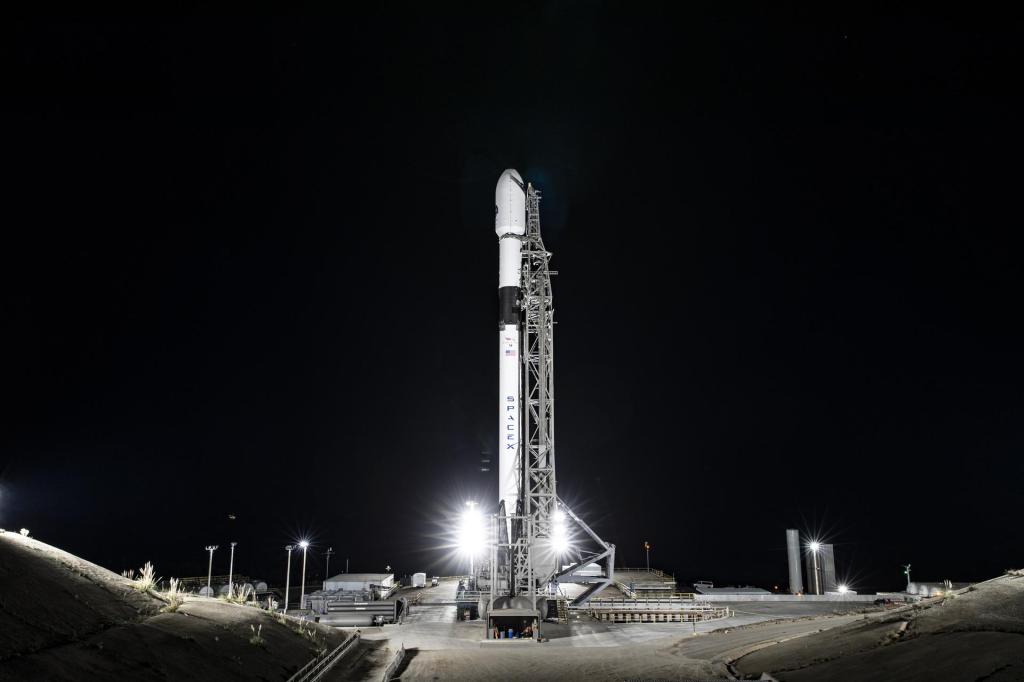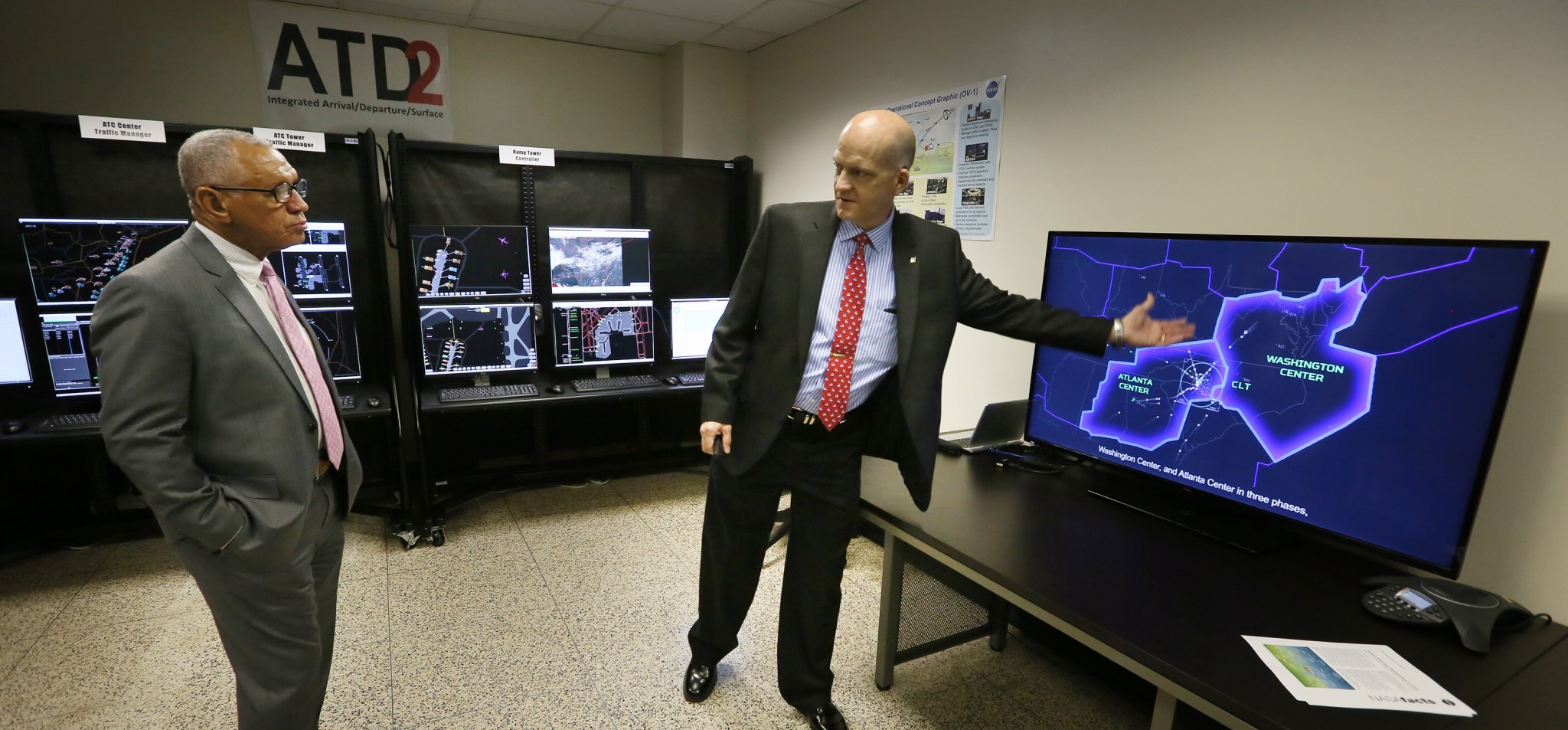The forward cabin door is closed. Everyone is sitting down with their seat belts fastened. Then comes the gentle nudge as the airliner is pushed back from its gate.
After a grueling, week-long business trip, home is just two hours away – and you can’t wait to see family, friends and your own bed!
Then the aircraft stops, and you have no choice but to wait some more. It’s another 10 minutes before you start moving again. Another stop. Another wait – this time for a turn to take off behind a bunch of aircraft in front of you.
Thirty minutes after departing the gate, your patience all but shot, the airplane accelerates into the sky and you wonder why this whole process of getting from the gate to cruising altitude has to be so difficult and delay-prone?
Turns out there’s a legitimate answer to that question and NASA’s aeronautical innovators are clued in on a solution to the problem. The goal: minimize those frustrating delays, if not eliminate them altogether.
The solution is called ATD-2, short for Airspace Technology Demonstration-2, and after years of research, systems development and training it’s now being tested at Charlotte-Douglas International Airport in North Carolina.
Begun Sept. 29, ATD-2 is a three-year field demonstration of software solutions to better manage air traffic to and from Charlotte, with an emphasis on more efficiently handling aircraft movements between gate and runway.
The shakedown of technology and new procedures involves NASA closely working with the Federal Aviation Administration (FAA), the air traffic controllers union, American Airlines and officials at Charlotte.
“To the traveling public it’s a lot of work behind the curtain you’ll never see,” said Leighton Quon, NASA’s ATD project manager at the Ames Research Center in California.
“But if we can get all the many players involved sharing the same information, seeing the same picture and working together, once you start moving you’re going to keep moving smoothly through the system,” Quon said.
The problem, and its solution, begin with knowing today’s air traffic management system already relies on a lot of modern technology – much of it developed by NASA – which helps make flying among the safest forms of transportation in the world today.
But at the same time, a lot of the process still is based on very old concepts of people monitoring radar or using binoculars to look at airplanes through a window, such as at an air traffic control tower.
Coordination between the various air traffic management facilities frequently requires a manual effort, even to the extent that when one controller from one facility needs to exchange information with another controller in another facility, it may happen with a telephone call.
And if the phone line is busy, an airplane with 135 passengers can wind up sitting on a ramp waiting for its turn to take off, having missed a chance to get into the air and merge into the overhead traffic – a key problem ATD-2 is designed to address.
Who’s On First?
In sports, it is said, you can’t tell the players without a program. In air traffic management, you can’t have a program to make things better without understanding who the players are that need to be brought together as a team.
So, considering a typical airline flight departing from a major airport, the first player involved is a traffic manager who is the ramp tower controller. These controllers often are airline or airport employees and are responsible for the parts of the airport that are not controlled by the FAA.
It’s the job of the ramp controller to tell the pilot when it’s okay to push back from the gate and taxi to the point at which the FAA air traffic control tower becomes responsible for guiding the airplane out to the runway and clearing if for takeoff.
Once airborne, the FAA tower hands off the airplane to a TRACON, short for Terminal Radar Approach Control. It’s essentially a donut-shaped volume of airspace centered on the airport that can extend up to 100 miles in diameter.
As an aircraft climbs to its cruising altitude through the TRACON airspace, the traffic manager there eventually passes control of the flight to a colleague at an Air Route Traffic Control Center. There are 21 Centers managing high-altitude air traffic across the entire United States.
When an airliner nears its destination, the process is reversed: the Center hands off to the TRACON, who hands off to the air traffic control tower, who hands off to the ramp tower with the flight ending at the arrival gate.
Predictability is the Key
What ATD-2 is demonstrating is a new way for all of these players to collaborate by sharing the same information about where an aircraft is, where it needs to be and when it needs to be there at every step of its flight.
Instead of relying on a telephone call, for example, the pertinent information is instantly seen on monitors whose computers are loaded with NASA-developed ATD-2 software networked among the Center, TRACON, FAA tower and ramp tower.
By using new software capable of receiving and crunching traffic-related input from dozens of information sources, air traffic managers can more reliably predict and better coordinate among them an aircraft’s movements from gate to gate.
“Making aircraft movements more predictable leads to several benefits,” said Shawn Engelland, NASA’s ATD-2 project manager. Those benefits include:
- Enabling more aircraft into the overhead stream by not letting open slots go unused because of delays on the ground.
- Making it possible for passengers to spend less time on an unmoving aircraft, either waiting to push back from the gate or sitting idle on a taxiway waiting for a turn to take off.
- Reducing fuel burn, emissions and expense from an idling aircraft waiting to move.
Ultimately, ATD-2 also will enable airlines to reduce the schedule padding put on flights today to account for uncertainty on the ground, and that will help passengers more reliably get to their destinations on time.
Ground Transportation This Way
And while improvements in managing the timing of every phase of a flight – taxi, takeoff, cruise, landing, taxi – can contribute to reducing delays, for ATD-2 one of the key drivers behind the system is to better handle aircraft surface movements.
“Once again, we’re talking about predictability. If we can better predict the exact time an aircraft should push back from its gate, we can better plan to manage that aircraft’s movements out to the runway and up into the overhead stream,” Engelland said.
ATD-2 takes advantage of a five-year FAA and industry effort on a project called Surface Collaborative Decision Making, which addressed the technology and procedures required to make pre-departure planning and airport surface operations more efficient.
In fact, one reason the Charlotte airport was selected for ATD-2 is because it has unique challenges related to surface operations.
Although it has the runways and air traffic of a major international airport, its available ramp space is only about the size of a smaller regional airport. As waves of flights come and go through the day, traffic jams can be too common.
“Picture an aircraft carrier that has airplanes taxiing, taking off and landing on the relatively small deck. Charlotte isn’t that small, but you get the idea of the challenges of managing all of those aircraft surface movements,” Engelland said.
ATD-2 shines in this area by integrating NASA arrival, surface and departure technology developed with its partners and turned over to the FAA for their further testing and eventual deployment.
ATD-2 Rolls Out
Having begun Sept. 29 with an initial set of capabilities, the full ATD-2 demonstration will take three years to complete as new capabilities are added and other players are folded in to the live operations.
“We couldn’t put it out there all at once because it’s too big,” Quon said.
“We’re following a classic crawl, walk, run scenario as we introduce this system and the air traffic managers and controllers increasingly adopt it and learn to rely on and trust in it for their live operations,” Engelland said.
So far, as planned, only the Charlotte TRACON and FAA tower are consistently and actively using the NASA technology installed in those facilities.
At Charlotte’s ramp tower, run by American Airlines, the ramp traffic coordinators there also have access to the NASA technology now, and by throwing a switch can shift their displays between showing the NASA system and the commercial software they regularly use.
At the Washington Center, which Charlotte feeds into, the traffic management coordinator there still is using the FAA system they normally look at, but NASA information and data from the FAA system are being shared “behind the scenes.”
“This is part of the story we’re particularly proud of,” Engelland said. “The collaboration required to integrate the key airport surface component of NASA’s ATD-2 with the FAA’s operational system was nothing less than outstanding.”
“So, all of these traffic managers are all using NASA technology to communicate with each other to solve this merge into the overhead stream problem by pushing back from the gate at the right time,” Engelland said.
Nearly a month into the field demonstration, everyone associated with the demonstration seems to like what they see.
“I would say the indications are things are going well, and actually better in terms of the number of hours the NASA technology is being used,” Engelland said. “We’ve gotten more hours of use at this point in time than we had expected to. That’s really making me feel good.”
Feedback from the traffic managers and controllers so far has been positive along with many excellent ideas on how to improve the system, and confidence in the new tools remains high, Quon said.
At the conclusion of the three-year demonstration the NASA-developed technology will be transferred to the FAA and industry for possible implementation in future air traffic management systems at airports and air traffic management facilities across the nation.






































